We may not have the course you’re looking for. If you enquire or give us a call on 01344 203999 and speak to our training experts, we may still be able to help with your training requirements.
We ensure quality, budget-alignment, and timely delivery by our expert instructors.

Juggling resources, deadlines, and risks is the biggest uphill battle for any Project Manager. When deadlines keep shifting, resources stretch thin, and chaos threatens to overwhelm any project, it can feel like herding cats. That’s where Primavera P6 comes in as your ultimate Project Management ally. This tool helps you with detailed planning, Resource Management, and Risk Analysis, and is used across industries like Construction, Engineering, and Manufacturing.
While the features of Primavera P6 are strong, mastering it takes significant skill. If you want to know why it's the go-to option for top Project Managers, this blog will provide the answer. So read on and learn what makes Primavera P6 a game-changer!
Table of Content
1) What is Primavera P6?
2) Who Uses Primavera P6?
3) How to use Primavera P6?
4) Features of Primavera P6
5) Pros and Cons of Primavera P6
5) Best Practices for using Primavera P6
6) Challenges in Using Primavera P6
7) Primavera P6 vs Other Project Management Tools
8) Is Primavera better than MS Project?
9) Is Primavera part of BIM?
10) Conclusion
What is Primavera P6?
Primavera P6 is a Project Management software created by Oracle, allowing you to plan, manage and analyse projects efficiently. This software has had a diverse use across different industries, such as Information Technology (IT), manufacturing and construction. It has been used to handle small and large-scale projects, making the Project Management process smoother.
One may even consider Primavera the ultimate Project Management software that has gained popularity and trust among organisations over time. It has been a standard tool in different industries since the year 1983. Over the last 30 years, this software underwent many changes, with resources like Primavera P6 Books helping professionals master its functionalities, and it came under Oracle’s possession in 2008.
Due to the significant advancement of technology in this period, it split into two different versions, as follows:
1) Primavera P6 PPM
One version of Primavera was made into desktop-based application software. This version was called Primavera P6 Project Portfolio Management (PPM). This software allows you to establish relationships between different activities and serialise your work proses. Contractors commonly prefer this tool due to its easy installation process, thus, its higher convenience.
Large organisations commonly use P6 PPM due to its shared server. This is because the software allows different employees to keep up with the updates on each activity. This tool uses Critical Path Method (CPM) algorithm, allowing it to manage as many as 100000 activities.
2) Primavera P6 EPPM
Another version of Primavera was a web server-based tool called Primavera P6 Enterprise Portfolio Management. This version stores all your necessary information in its central database. EPPM possesses certain advantages over PPM, such as not needing to install the tool to use it. This makes it an excellent choice for medium and large-scale businesses as they require large-scale infrastructure.
The EPPM has its shortcoming as it has its benefits. On the one hand, EPPM benefits greatly from being more storage-friendly and possessing better multitasking options. It benefits from having a Work Breakdown Structure (WBS) screen, bucket planning and text reports. On the other hand, EPPM suffers from network issues, as it relies on your internet to work correctly.
Learn about resource codes with our course in Primavera P6 Professional Advanced Course!
Industries Which Use Primavera P6
Project Managers rely on Oracle Primavera P6 to execute projects, programs, or entire portfolios effectively. Various industries widely adopt Primavera P6 including:
1) Aerospace and defence,
2) Construction
3) Oil and gas
4) Government agencies
5) Energy and utilities
6) Biotech firms
Given its complexity and power, taking a training course in is recommended to master the software and leverage its full potential for managing intricate projects.
Job Roles That Utilise Primavera P6
Many project professionals hold job roles that may require the use of Primavera P6. These roles include:
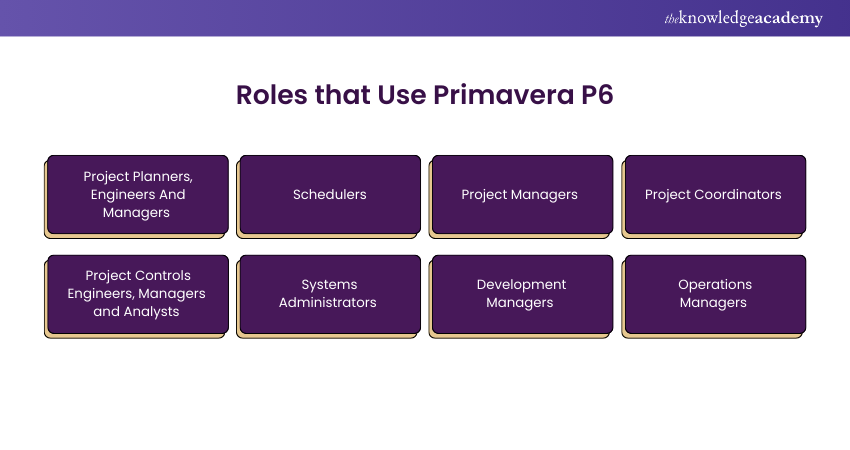
1) Project Planners, Planning Engineers and Planning Managers
2) Schedulers
3) Project Managers
4) Project Coordinators
5) Project Controls Engineers, Managers and analysts
6) Systems Administrators
7) Development Managers
8) Operations Managers
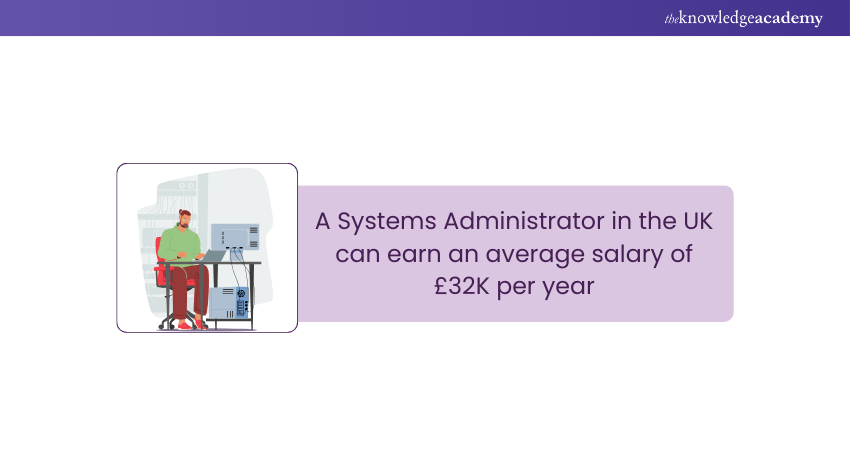
How to Use Primavera P6?
Primavera P6 is commonly used by a Project Manager regardless of the field and industry. As a result, Senior Engineers, Project Managers, and Team Leaders all use the software to make their work more linear. Using this tool generally consists of these given steps:
Use in Time Management
Primavera P6 allows you to create schedules, which simplifies the Time Management process of projects. This tool achieves this by using WBS and drawing relationship diagrams between activities. Primavera allows you to create schedules between these activities specifying the duration of the activities and calculating the most efficient way to approach these tasks with Critical Path Method (CPM).
Use in Enterprise Project Management
Primavera P6 allows you to work alongside different users in an enterprise on the same project, thanks to a shared database. This shared database uses a web interface to connect the web server with users. This software then arranges all ongoing projects in an Enterprise Project Structure (EPS) within the database.
Master the concepts of Shell Manager Configuration and Company User Administration in our Primavera Unifier Administration 15 Training - Sign up now!
Use in Resource and Cost Management
Primavera allows you to calculate the cost of an activity based on its duration by applying a unit price to resources. The tool will enable you to gauge the estimated project activity cost and root out errors by cross-checking the estimated cost with the actual cost. Additionally, it allows you to factor in minor details, such as direct and indirect costs, while allotting resource prices.
Use in Risk Management
When you hear the word “risk” in a business environment, it refers to things and events that can cause failure. Risks can sabotage a well-designed project if nothing is done about them. Primavera allows you to detect and categorise these risks based on their severity. It has the benefit of allowing you to prioritise these risks while approaching to solve them.
Use in Threshold Management
The term threshold refers to the limits or parameters of a project. Primavera allows you to assign a project's upper and lower threshold. It will enable you to determine the maximum and minimum capacity of the project you are working on.
Use in Issue Management
Issue limit management works alongside the Threshold Management feature of Primavera P6 software. Issue refers to a notion or message made to gain the attention of users. When a project hits its maximum threshold, this tool creates an issue, addressing the threshold limit being bypassed. You can use emails in this tool to notify other team members about the raised issue.
Use in Reporting
Review and Reports are essential phases in any business process, allowing you to verify a task done. Primavera P6 aids your reporting process with features such as future performance estimation, current performance evaluation and displaying the current project’s status. You can customise your reports in PPM and EPPM with its database, with some common report styles being Stacked Histogram reports, earned value reports, and Schedule Performance reports.
Master Project Management software in a business environment with Primavera Training – register now!
Features of Primavera P6
Primavera P6 has certain features that make it desirable for both small- and large-scale businesses alike, which may be highlighted in Primavera P6 Interview Questions. Here are some features that might make it worth your and your organisation’s time.
Project Modelling-based Features
This includes all the necessary features relevant to project creation and management. Some such standard features within the Primavera P6 software are as follows:
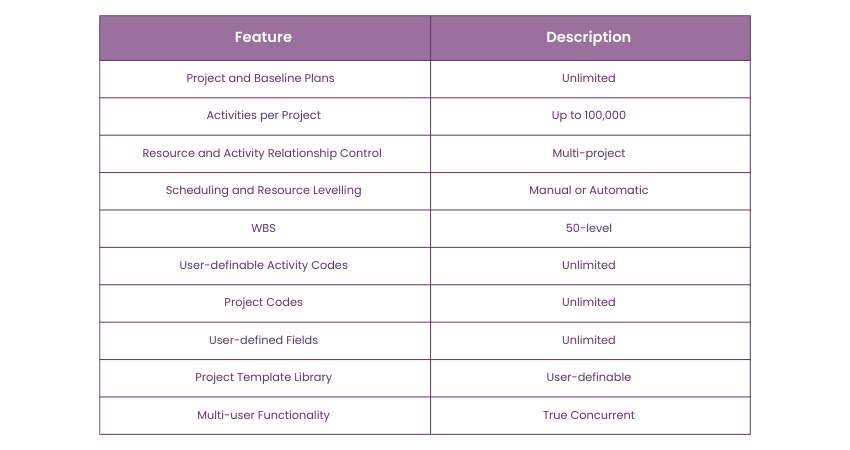
Resource and Cost Management-based Features
These features reflect a tool’s ability to manage financial resources, people and all-over costs. Some cost estimation and management features of Primavera P6 are as follows:
1) Hierarchical resource pool for all projects
2) Resource calendars and variable availability
3) Unlimited resources per activity
4) Nonlinear resource per activity
5) Prioritisable forward and backward levelling
6) Selective and timer-limited levelling
7) Variable resource pricing and availability
8) Resource-driven activity durations
9) Earned value tables and curves
10) Scheduled Budget tables and curves
Scheduling-based Features
This includes Time Management and Relationship Analysis features of Primavera, as well as insights from the comparison of Primavera P6 vs MS Project. These features allow you to set and follow necessary deadlines within a project. Some such features include:
1) Critical Path Scheduling (CPM).
2) Precedence Diagramming Method (PDM).
3) Free and total float calculation.
4) Finish-to-start, Start-to-start, Start-to-finish and Finish-to-finish activity relationships.
5) All relationships with user-definable lead and log (positive and negative).
6) Unlimited number of activity calendars.
7) Time units in hours, days, weeks and months.
8) 9 types of schedule constraints including Mandatory Start, Mandatory Finish, and Start On or Finish On
9) 6 types of activities for more precise schedule modelling including Task dependents, Start milestone, Finish milestone and Level of effort.
10) Suspend and resume dates for in-progress activities.
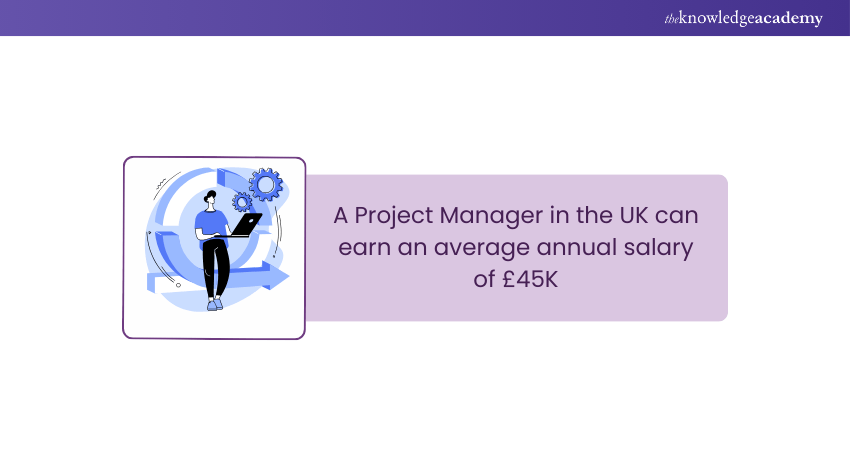
Become familiar with different reports scheduling in P6 and BI Publisher in our comprehensive Primavera P6 Reporting With BI Publisher 11g Course - Sign up now!
Reports and Graphics-based Features
These include the visual elements and features of Project Management Software. These allow you to visualise data on the project’s progress and current status. Some such reporting features of Primavera P6 are listed below:
1) Tabular reports and graphics
2) Report wizard and report editor
3) Report wizard and report editor
4) Complete customisation of display output
5) HTML publishing of layouts and reports
6) Unlimited presentation layouts
7) Hierarchical project outlining organised by any combination of activity codes and WBS
8) Summarise and group activities and compare baselines
9) Time-scaled bar (Gannt) charts with logic
10) Necking and activity code colours/patters on Gatt bars WBS chart
Pros and Cons of Primavera P6
While there are many things that Primavera P6 does well, this tool is not without its fair share of drawbacks. Here's a list of its pros and cons to consider:
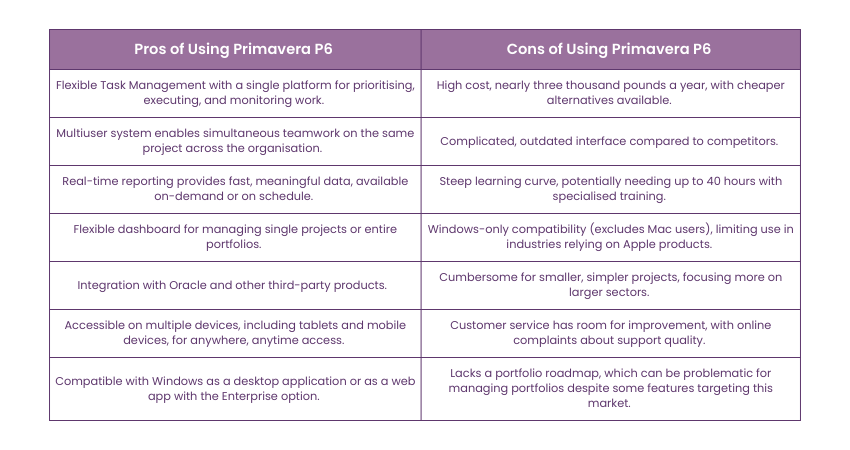
Best Practices for using Primavera P6
Consider these best practices to effectively use Primavera P6:
1) Project Setup: Establish a clear Work Breakdown Structure (WBS) to define the project scope and ensure consistency in project planning.
2) Data Integrity: Regularly update and monitor your project data for accuracy. This will help you maintain a reliable project schedule.
3) Resource Management: Assign resources effectively to balance workloads. This will help you avoid over-allocation and ensure optimal resource utilisation.
4) Baseline Planning: Always establish a baseline for your projects. This allows for better tracking of progress versus planned schedules.
5) Training and Support: Invest in training for users to ensure they understand the software's capabilities and functionalities.
Master the concepts of project structures, successor relationships and baselining project plans in our Primavera P6 EPPM Advanced Course – Register now!
Challenges in Using Primavera P6
Primavera P6 is a powerful Project Management tool, but users often encounter several challenges:
1) The software's calendar system can become unwieldy, especially when multiple global calendars are created during project imports. This can lead to confusion and scheduling inaccuracies if not properly managed.
2) Users have reported problems with activity relationships, such as Finish-to-start (FS) dependencies not behaving as expected. This can lead to scheduling conflicts and require manual adjustments.
3) Effectively managing resources in P6 can be challenging, leading to overallocation issues that impact project timelines and budgets.
4) The extensive features and options in P6 can make the user interface overwhelming, particularly for new users, leading to a steep learning curve.
5) Transferring data between P6 and other software can be problematic, sometimes resulting in data loss or corruption.
Primavera P6 Vs Other Project Management Tools
Here are the key differences between Project Management tools such as Asana, Primavera P6, Jira and MS project:

Is Primavera better than MS Project?
Primavera is often favoured for large-scale Construction and Engineering projects due to its advanced features for managing complex schedules and resources. MS Project is more user-friendly and suitable for smaller projects or general Project Management tasks.
Is Primavera part of BIM?
Primavera is not inherently part of Building Information Modelling (BIM). However, it can aid BIM processes by providing Project Management tools that help plan, schedule, and control those construction projects that utilise BIM.
Learn Primavera P6 step by step – Get your free Primavera P6 Manual Guide today!
Conclusion
Through its robust features, flexibility, and real-time capabilities, Oracle Primavera P6 offers the ideal solution for mastering complex Project Management. While its complexity and cost may present challenges, its benefits far outweigh the drawbacks. The features, pros and cons of this tool outlined in this blog will empower you with the essential knowledge to elevate your Project Management skills and drive your projects to successful completion.
Expand your Primavera knowledge base with our Primavera P6 Dashboards and Reporting Course – Sign up now!
Frequently Asked Questions
What is the Purpose of Primavera?

Primavera is enterprise project Portfolio Management software for planning, managing, and executing project work. It’s designed for large and small projects across various industries, such as construction, manufacturing, energy, and IT.
Why is Primavera Called P6?

The “P6” in Primavera P6 refers to the version number of the software. It was informally called “P5” by users before Version 6 was officially named “P6” by Primavera.
What are the Other Resources and Offers Provided by The Knowledge Academy?

The Knowledge Academy takes global learning to new heights, offering over 3,000 online courses across 490+ locations in 190+ countries. This expansive reach ensures accessibility and convenience for learners worldwide.
Alongside our diverse Online Course Catalogue, encompassing 19 major categories, we go the extra mile by providing a plethora of free educational Online Resources like News updates, Blogs, videos, webinars, and interview questions. Tailoring learning experiences further, professionals can maximise value with customisable Course Bundles of TKA.
What is The Knowledge Pass, and How Does it Work?

The Knowledge Academy’s Knowledge Pass, a prepaid voucher, adds another layer of flexibility, allowing course bookings over a 12-month period. Join us on a journey where education knows no bounds.
What are Related Courses and Blogs Provided by The Knowledge Academy?

The Knowledge Academy offers various Primavera Training, including the Primavera P6 Professional Fundamentals Course, Primavera P6 Professional Advanced Course and Primavera Unifier Administration 15 Course. These courses cater to different skill levels, providing comprehensive insights into Primavera Job Roles.
Our Office Applications Blogs cover a range of topics related to Primavera, offering valuable resources, best practices, and industry insights. Whether you are a beginner or looking to advance your Project Management skills, The Knowledge Academy's diverse courses and informative blogs have got you covered.
Upcoming Office Applications Resources Batches & Dates
Date
 Primavera P6 Professional Fundamentals
Primavera P6 Professional Fundamentals
Mon 12th May 2025
Mon 7th Jul 2025
Mon 1st Sep 2025
Mon 3rd Nov 2025






 Top Rated Course
Top Rated Course



 If you wish to make any changes to your course, please
If you wish to make any changes to your course, please


